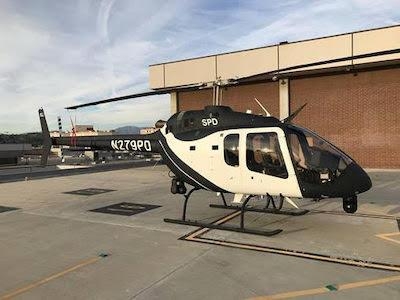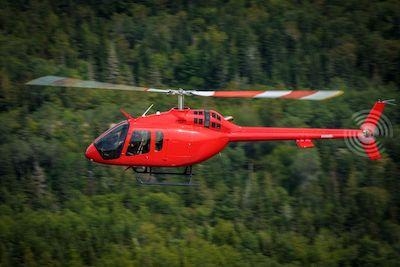AD 2021-11-19 Requires Inspecting The Transmission Restraint Aft Attachment Hardware Installation
The FAA is adopting a new airworthiness directive (AD) for Bell Textron Canada Limited (type certificate previously held by Bell Helicopter Textron Canada Limited) (Bell) Model 505 helicopters.

This AD was prompted by the discovery of a gap between the transmission restraint assembly aft attachment hardware lower washer and mating airframe truss assembly (truss assembly) clevis lower lug. This AD requires inspecting the transmission restraint aft attachment hardware installation for a gap and corrective action depending on the inspection results. The FAA is issuing this AD to address the unsafe condition on these products. This AD is effective July 16, 2021.
Supplementary Information: The FAA issued a notice of proposed rulemaking (NPRM) to amend 14 CFR part 39 by adding an AD that would apply to Bell Model 505 helicopters with a truss assembly part number (P/N) SLS030-056-015 with a serial number (S/N) listed in Attachment A of Bell Alert Service Bulletin (ASB) 505-19-12, Revision A, dated July 11, 2019 (505-19-12 Rev A). The NPRM published in the Federal Register on March 22, 2021 (86 FR 15146). In the NPRM, the FAA proposed to require the following within 100 hours time-in-service (TIS):
- Accessing and cleaning the lower attachment hardware securing the restraint to the truss assembly, loosening the torque on each lower nut to measure the tare, and adding a torque value of 20 inch-lbs to the measured tare of each nut and torqueing each nut to this new total value.
- Inspecting for a gap around the circumference between the nut and the washer and between the washer and the truss assembly clevis lower lug mounting surface of the right-hand (RH) and left-hand (LH) sides, and if there is a gap, measuring the gap.
- If there is a gap that is less than 0.003 inch (0.076 mm), installing the hardware using the original torque value of 40 to 58 foot-pounds (55 to 78 Nm) plus tare and completing the installation of the attachment point.
- If there is a gap that is 0.003 inch (0.076 mm) to 0.020 inch (0.508 mm) inclusive, installing the hardware with a decreased torque value limit of 20 to 60 inch-pounds (2.3 to 6.8 Nm) plus tare and completing the installation of the attachment point. The NPRM also proposed to require updating records for your helicopter to indicate the new torque limits on one or both sides. Thereafter, within 100 hours TIS, and thereafter at intervals not to exceed 100 hours TIS, the NPRM proposed to require inspecting the assembly for fretting between the washer and truss lower lug mounting surface, the security of the pitch restraint attachment hardware to make sure it does not turn freely, and the torque seal lacquer between the nut and the washer to make sure the torque seal is intact on the RH and LH sides. Depending on the inspection results, the NPRM proposed to require removing the cotter pin from service and removing the nut, washer, and bolt, and inspecting the bolt and the lower surface of the truss
assembly clevis lower lug. Depending on these inspection results, the NPRM proposed to require removing the bolt from service; reworking and cleaning the lower surface of the clevis lower lug and inspecting for any cracks; removing the clevis lower lug from service; or applying primer and final paint. The NPRM then proposed to require installing the hardware with a decreased torque value limit of 20 to 60 inch-pounds (2.3 to 6.8 Nm) plus tare and completing the installation of the attachment point.
- If there is a gap that is more than more than 0.020 inch (0.508 mm), removing the nut, washer, and bolt from service and repairing or replacing the truss assembly clevis lower lug in accordance with FAA-approved procedures.

The NPRM was prompted by Canadian AD CF-2019-35, dated October 2, 2019 (Transport Canada AD CF-2019-35), issued by Transport Canada, which is the aviation authority for Canada, to correct an unsafe condition for Bell Model 505 helicopters, S/Ns 65011 and subsequent. Transport Canada advises of a gap between the transmission restraint assembly aft attachment hardware lower washer and the lower lug of the truss assembly clevis identified during quality control activity of a helicopter in final assembly. This gap can occur on the RH and LH sides of the truss assembly clevis.
Subsequent investigation revealed that this condition may exist on in-service helicopters. Transport Canada advises that excessive gapping at either of these locations will result in increased stress when fasteners are installed and that the increased stress may result in cracking on the clevis lower lug and subsequent failure of one or both clevis lower lugs. Transport Canada further advises that this condition, if not corrected, could lead to loss of pylon pitch stiffness, excessive pylon pitch motions leading to unknown cyclic inputs to the main rotor, and consequent loss of control of the helicopter.
Accordingly, Transport Canada AD CF-2019-35 requires identifying the S/N of the installed truss assembly, and for a helicopter with an affected truss assembly installed, performing an initial inspection of the transmission restraint aft attachment hardware installations for a gap. Depending on the inspection results, Transport Canada AD CF-2019-35 requires reducing the torque to the attachment hardware, updating records, and repetitive inspections of the attachment hardware for wear and fretting because of the reduced friction between the mating surfaces; reporting findings to Bell and accomplishing corrective actions specified by Bell; or completing the installation of the attachment hardware and updating records.
 ANN's Daily Aero-Term (04.28.24): Airport Marking Aids
ANN's Daily Aero-Term (04.28.24): Airport Marking Aids Aero-News: Quote of the Day (04.28.24)
Aero-News: Quote of the Day (04.28.24) ANN's Daily Aero-Linx (04.28.24)
ANN's Daily Aero-Linx (04.28.24) Aero-News: Quote of the Day (04.29.24)
Aero-News: Quote of the Day (04.29.24) ANN's Daily Aero-Linx (04.29.24)
ANN's Daily Aero-Linx (04.29.24)




